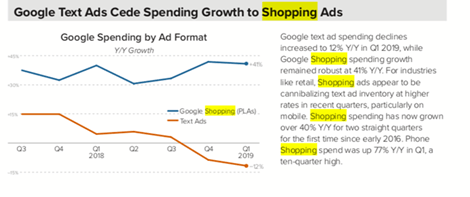According to eMarketer, paid search ad spend will grow 22.5 percent to $13.12 billion this year, and retail will account for the largest share of search dollars at nearly one-quarter of the total U.S. search market. Two of the primary draws for that growth are Google Shopping ads and local inventory ads, as Merkle’s Q1 2019 Digital Marketing Report illustrates:
Credit: Merkle

Credit: Merkle
It’s more important than ever to optimize paid search strategies like bids, messaging and targeting to generate the best return. To do so effectively, retailers must recognize that consumer calls are an important part of the customer journey and a source of invaluable insights for optimization.
Google Shopping campaigns and local inventory ads generate high volumes of calls to many retailers, especially in verticals where the purchase is complex or expensive. Typically, call volume grows in step with these ad channels.
About the Ad Types
- Google Shopping Ads: According to Google, shopping ads are “more than a text ad — they show users a photo of your product, plus a title, price, store name, and more. These ads give users a strong sense of the product you’re selling before they click the ad, which gives you more qualified leads.”
- Local Inventory Ads: According to Google, “local inventory ads showcase your products and store information to nearby shoppers searching with Google. When shoppers click your ad, they arrive on a Google-hosted page for your store, called the local storefront. Shoppers use the local storefront to view in-store inventory, get store hours, find directions, and more.”
Since Google Shopping ads and local inventory ads are growing in popularity, it’s important for retailers to optimize them effectively and get a strong return on ad spend. That’s where consumer call data comes in.
Optimization Through Phone Calls
Calls from Google Shopping and local inventory ads not only convert at high rates, but they also contain insights into that caller’s intent, product interest, preferences, and value to the business. Here are three optimization techniques driven by call data that can take these ads to a whole new level:
Attribute calls to marketing channels.
By collecting call data from prospective and current customers, including what was actually said in the conversation, retailers can identify the specific marketing channel, ad creative and landing page combinations that trigger the highest call volume and most sales from calls to each location. They can then leverage this information to optimize their audience targeting, creative, landing pages and more.
Drive new callers.
Don’t waste paid search budgets generating calls from existing customers; those calls are often support-related and can be generated via a nonpaid channel like search engine optimization. By understanding if your ads are generating new vs. repeat callers — and how often callers are asking customer support-related questions — retailers can make smarter optimizations to drive more of the right types of callers and reduce cost per lead (CPL).
Improve audience targeting.
Consumer conversations are a rich source of insights into that caller’s intent, urgency, product/service interest, and value. Retailers can reduce CPL from Shopping and local inventory ads by using intelligence from those conversations to add callers to the most relevant audience segments:
- For unconverted callers who had conversations that indicated that they were a quality lead, retarget them with a special offer for the product/service they called about.
- For callers who converted into customers, put them into the most relevant upsell or cross-sell ad campaigns. Add them to lookalike campaigns to extend reach and find new prospects resembling the best leads.
- For callers whose conversations show they aren’t sales leads, add them to exclusion lists so you don’t waste budget showing them irrelevant ads. By excluding these callers who inquired about customer support or employment, you’ll focus your budget on the leads that matter.
Kayla Hammersmith is senior content marketing manager at DialogTech, the world leader in call analytics for marketers.
